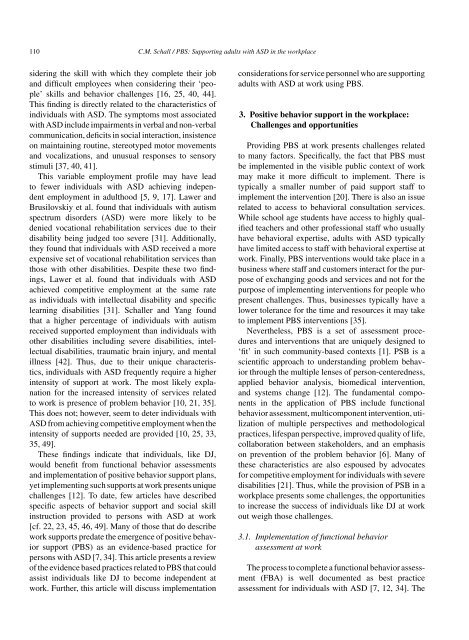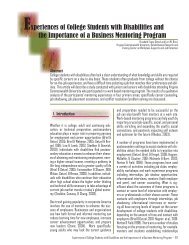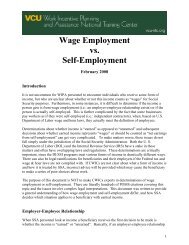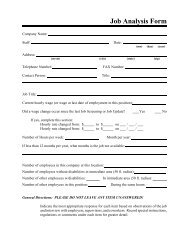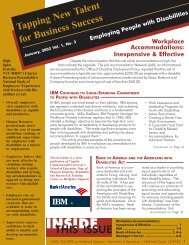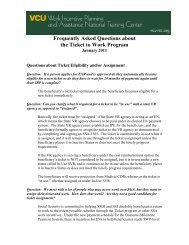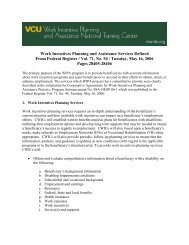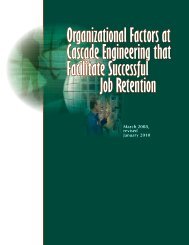Supporting adults with autism spectrum disorders in the ... - IOS Press
Supporting adults with autism spectrum disorders in the ... - IOS Press
Supporting adults with autism spectrum disorders in the ... - IOS Press
You also want an ePaper? Increase the reach of your titles
YUMPU automatically turns print PDFs into web optimized ePapers that Google loves.
110 C.M. Schall / PBS: <strong>Support<strong>in</strong>g</strong> <strong>adults</strong> <strong>with</strong> ASD <strong>in</strong> <strong>the</strong> workplacesider<strong>in</strong>g <strong>the</strong> skill <strong>with</strong> which <strong>the</strong>y complete <strong>the</strong>ir joband difficult employees when consider<strong>in</strong>g <strong>the</strong>ir ‘people’skills and behavior challenges [16, 25, 40, 44].This f<strong>in</strong>d<strong>in</strong>g is directly related to <strong>the</strong> characteristics of<strong>in</strong>dividuals <strong>with</strong> ASD. The symptoms most associated<strong>with</strong> ASD <strong>in</strong>clude impairments <strong>in</strong> verbal and non-verbalcommunication, deficits <strong>in</strong> social <strong>in</strong>teraction, <strong>in</strong>sistenceon ma<strong>in</strong>ta<strong>in</strong><strong>in</strong>g rout<strong>in</strong>e, stereotyped motor movementsand vocalizations, and unusual responses to sensorystimuli [37, 40, 41].This variable employment profile may have leadto fewer <strong>in</strong>dividuals <strong>with</strong> ASD achiev<strong>in</strong>g <strong>in</strong>dependentemployment <strong>in</strong> adulthood [5, 9, 17]. Lawer andBrusilovskiy et al. found that <strong>in</strong>dividuals <strong>with</strong> <strong>autism</strong><strong>spectrum</strong> <strong>disorders</strong> (ASD) were more likely to bedenied vocational rehabilitation services due to <strong>the</strong>irdisability be<strong>in</strong>g judged too severe [31]. Additionally,<strong>the</strong>y found that <strong>in</strong>dividuals <strong>with</strong> ASD received a moreexpensive set of vocational rehabilitation services thanthose <strong>with</strong> o<strong>the</strong>r disabilities. Despite <strong>the</strong>se two f<strong>in</strong>d<strong>in</strong>gs,Lawer et al. found that <strong>in</strong>dividuals <strong>with</strong> ASDachieved competitive employment at <strong>the</strong> same rateas <strong>in</strong>dividuals <strong>with</strong> <strong>in</strong>tellectual disability and specificlearn<strong>in</strong>g disabilities [31]. Schaller and Yang foundthat a higher percentage of <strong>in</strong>dividuals <strong>with</strong> <strong>autism</strong>received supported employment than <strong>in</strong>dividuals <strong>with</strong>o<strong>the</strong>r disabilities <strong>in</strong>clud<strong>in</strong>g severe disabilities, <strong>in</strong>tellectualdisabilities, traumatic bra<strong>in</strong> <strong>in</strong>jury, and mentalillness [42]. Thus, due to <strong>the</strong>ir unique characteristics,<strong>in</strong>dividuals <strong>with</strong> ASD frequently require a higher<strong>in</strong>tensity of support at work. The most likely explanationfor <strong>the</strong> <strong>in</strong>creased <strong>in</strong>tensity of services relatedto work is presence of problem behavior [10, 21, 35].This does not; however, seem to deter <strong>in</strong>dividuals <strong>with</strong>ASD from achiev<strong>in</strong>g competitive employment when <strong>the</strong><strong>in</strong>tensity of supports needed are provided [10, 25, 33,35, 49].These f<strong>in</strong>d<strong>in</strong>gs <strong>in</strong>dicate that <strong>in</strong>dividuals, like DJ,would benefit from functional behavior assessmentsand implementation of positive behavior support plans,yet implement<strong>in</strong>g such supports at work presents uniquechallenges [12]. To date, few articles have describedspecific aspects of behavior support and social skill<strong>in</strong>struction provided to persons <strong>with</strong> ASD at work[cf. 22, 23, 45, 46, 49]. Many of those that do describework supports predate <strong>the</strong> emergence of positive behaviorsupport (PBS) as an evidence-based practice forpersons <strong>with</strong> ASD [7, 34]. This article presents a reviewof <strong>the</strong> evidence based practices related to PBS that couldassist <strong>in</strong>dividuals like DJ to become <strong>in</strong>dependent atwork. Fur<strong>the</strong>r, this article will discuss implementationconsiderations for service personnel who are support<strong>in</strong>g<strong>adults</strong> <strong>with</strong> ASD at work us<strong>in</strong>g PBS.3. Positive behavior support <strong>in</strong> <strong>the</strong> workplace:Challenges and opportunitiesProvid<strong>in</strong>g PBS at work presents challenges relatedto many factors. Specifically, <strong>the</strong> fact that PBS mustbe implemented <strong>in</strong> <strong>the</strong> visible public context of workmay make it more difficult to implement. There istypically a smaller number of paid support staff toimplement <strong>the</strong> <strong>in</strong>tervention [20]. There is also an issuerelated to access to behavioral consultation services.While school age students have access to highly qualifiedteachers and o<strong>the</strong>r professional staff who usuallyhave behavioral expertise, <strong>adults</strong> <strong>with</strong> ASD typicallyhave limited access to staff <strong>with</strong> behavioral expertise atwork. F<strong>in</strong>ally, PBS <strong>in</strong>terventions would take place <strong>in</strong> abus<strong>in</strong>ess where staff and customers <strong>in</strong>teract for <strong>the</strong> purposeof exchang<strong>in</strong>g goods and services and not for <strong>the</strong>purpose of implement<strong>in</strong>g <strong>in</strong>terventions for people whopresent challenges. Thus, bus<strong>in</strong>esses typically have alower tolerance for <strong>the</strong> time and resources it may taketo implement PBS <strong>in</strong>terventions [35].Never<strong>the</strong>less, PBS is a set of assessment proceduresand <strong>in</strong>terventions that are uniquely designed to‘fit’ <strong>in</strong> such community-based contexts [1]. PSB is ascientific approach to understand<strong>in</strong>g problem behaviorthrough <strong>the</strong> multiple lenses of person-centeredness,applied behavior analysis, biomedical <strong>in</strong>tervention,and systems change [12]. The fundamental components<strong>in</strong> <strong>the</strong> application of PBS <strong>in</strong>clude functionalbehavior assessment, multicomponent <strong>in</strong>tervention, utilizationof multiple perspectives and methodologicalpractices, lifespan perspective, improved quality of life,collaboration between stakeholders, and an emphasison prevention of <strong>the</strong> problem behavior [6]. Many of<strong>the</strong>se characteristics are also espoused by advocatesfor competitive employment for <strong>in</strong>dividuals <strong>with</strong> severedisabilities [21]. Thus, while <strong>the</strong> provision of PSB <strong>in</strong> aworkplace presents some challenges, <strong>the</strong> opportunitiesto <strong>in</strong>crease <strong>the</strong> success of <strong>in</strong>dividuals like DJ at workout weigh those challenges.3.1. Implementation of functional behaviorassessment at workThe process to complete a functional behavior assessment(FBA) is well documented as best practiceassessment for <strong>in</strong>dividuals <strong>with</strong> ASD [7, 12, 34]. The


